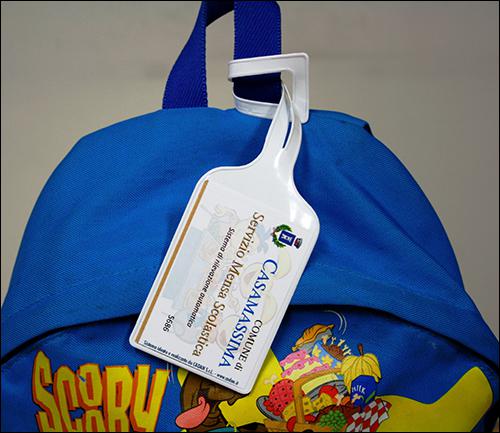Your location: Home Page > Industry News | SILION TECH > Italian Schools Automate Lunch Payments, Orders
News and Information
Italian Schools Automate Lunch Payments, Orders
Author:2020-02-18 18:03:51
Five public schools in Casamassima, a city in Italy's Apulia region, are using a radio frequency identification solution to identify children as they arrive, and to automate the ordering and payment of each child's lunch. Since the system was taken live in fall 2013, the technology has reduced the amount of labor for school personnel, ensured that food isn't wasted due to over-ordering and enabled parents to make lunch payments online.
The system consists of a passive ultrahigh-frequency (UHF) RFID tag attached to each student's backpack, a reader portal installed at each school's entrance, and software to manage the collected read data, issue alerts and make payment deductions for every meal.

A passive UHF RFID tag is attached to each student's backpack.
Casamassima has a population of approximately 19,000 people, with about 1,000 students (ages six to 10) attending the city's five primary schools. Traditionally, the students paid for meals using paper food stamps purchased by their parents at the municipal office, which the children then carried to school. A student handed a single food stamp over for each meal received at the cafeteria.
That process, however, was time-consuming for school personnel, who had to take the stamps from students and count them. If any question arose regarding whether a child was eligible for a meal (for instance, if he claimed to have lost his food stamp), the school opted to simply provide him with food. In addition, because the schools didn't know exactly how many lunch-buying students were present on a given day, they often purchased excess food, which was then discarded.
The district, therefore, sought an automated system that would not only eliminate the need for paper stamps and the handling of those stamps, but also enable each school to purchase the exact quantity of meals required on a particular day from its food caterer. The schools also wanted a solution that would be easier for parents, enabling them to make purchases online and view when they would need to order additional digital food stamps.
The schools simply didn't know how many students would be purchasing a lunch each day. And if there was doubt about whether a student was entitled to receive a meal, the school provided lunch even if that child's parents might not have paid for it, which cost the district money.
At the entrance to each school, a long-range reader is installed, and it is connected to two antennas.Each RFID tag's unique ID number is linked in the system with the corresponding child's name and payment status, as well as any special diet requirements or allergies.
When students arrive at school each morning, the reader at the building's entrance captures each child's backpack tag ID and forwards that data to the software residing on the school's database, via a Wi-Fi connection. The software identifies how many students will require each type of meal (based on diet requirements), and places that order with the caterer. It also automatically deducts the lunch cost from each child's account. The catering company can then prepare the exact number of meals required for that day.

At each school's entrance, RFID Global installed a Feig Electronics long-range reader, connected to two Feig antennas.
Since the system went live,the district has saved money previously spent to print food stamps for the 120,000 meals served annually. By eliminating the need for cafeteria workers to take the paper food stamps from children, as well as count, verify and manage them, the schools have reduced the labor required for the meal-purchasing process by 97 percent.
Casamassima's future plans are to expand the RFID solution to about 15 more schools within the district, such as secondary schools. The system can also be integrated with attendance software that stores each school's daily attendance records.